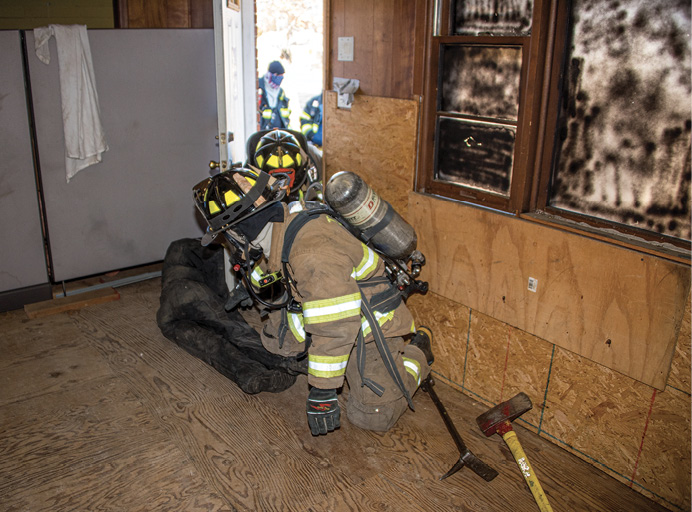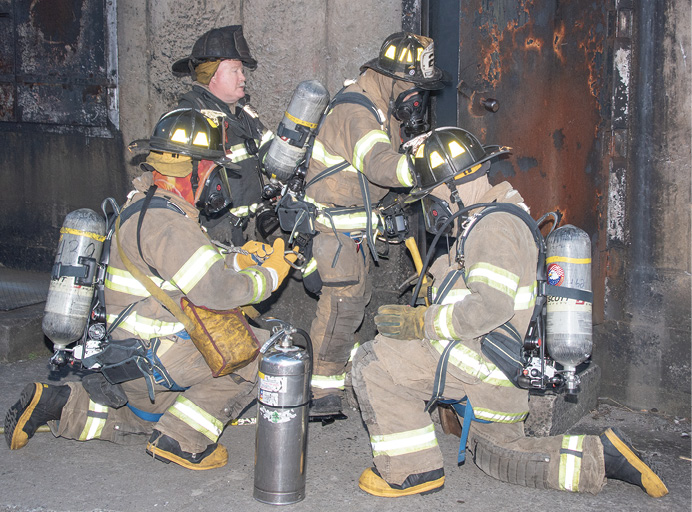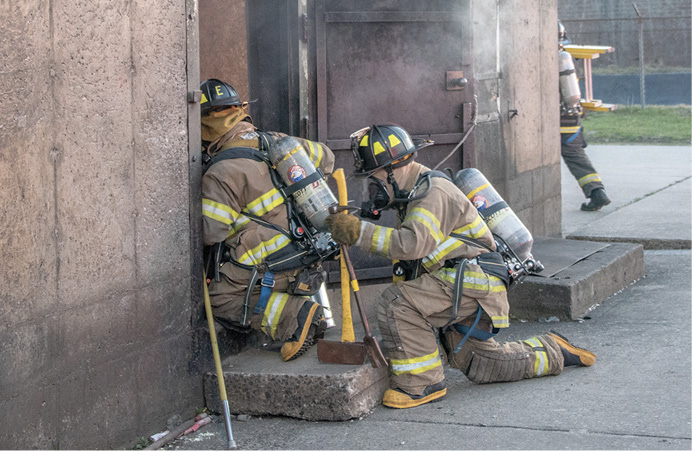As firefighters, our mission is clear: save lives and protect property. When we raise our right hand and take our oath of office, we swear to carry out our duties to the best of our ability. When we take our oath, nobody ever envisions making the ultimate sacrifice performing our sworn duty. With that in mind, firefighting is an inherently dangerous profession. We operate in an extreme environment of zero visibility, high heat, and rapidly deteriorating structural stability and experience physically demanding stress levels. We must make split-second decisions that can lead to a successful outcome or can lead to tragedy.
The fire service suffered the line-of-duty death (LODD) of Lieutenant Jason Menard of Worcester (MA) Fire Department Ladder 5 in November 2019. Menard was conducting a primary search for reported trapped occupants in a three-story, wood-frame private dwelling. While conducting the search, he and his inside team became trapped on the third floor. He performed heroically, saving one firefighter by getting him to the stairs and saving another by putting him out a window. The last LODDs (as of this writing) were Captain Raymond Figueroa and Firefighter Patrick Jones of the Porterville (CA) Fire Department in February 2020. While searching a library for occupants, they ran out of air and succumbed to their injuries.
RELATED FIREFIGHTER TRAINING
Searchable vs. Survivable: Educated Decision Making
Search and Rescue by the Numbers
Our mission at structural fires is fairly simple: locate, confine, and extinguish (LES). We must locate victims/fire, confine the fire area, and extinguish all visible and hidden fire. To locate fire and victims, a primary search must be conducted. Primary search, conducted in the initial stages of firefighting operations, is one of the most critical and potentially most dangerous tasks performed on the fireground.

(1) When performing a search, always check behind the door, especially if you meet resistance. (Photos by Dennis Whittam.)

(2) When performing a primary search in a commercial building, a large occupancy, or a building with maze-like conditions, consider using a search rope.
Primary searches are conducted at minor fires (smoke condition caused by an overheated light ballast, wall outlet smoking, food on the stove) and at serious fires (an occupied private dwelling, a multiple dwelling with reports of occupants trapped). Keep in mind that what appears to be a minor fire initially may turn out to be a serious fire hidden by walls and voids.
According to Rules of Engagement for Structural Firefighting: Increasing Firefighter Survival, developed by the International Association of Fire Chiefs Safety, Health and Survival Section in February 2012, “Our goal as firefighters is to save lives. The fire service has a long history of aggressive search and rescue operations as an initial priority of first arriving fire companies. History (and firefighter fatalities) also reflects that firefighters are exposed to the greatest risk of injury and death during primary search and rescue operations.”
The 10 Rules of Engagement for Structural Firefighting are as follows:
- Size up your tactical area of operation.
- Determine the occupant survival profile.
- DO NOT risk your life for lives or property that cannot be saved.
- Extend LIMITED risk to protect SAVABLE property.
- Extend vigilant and measured risk to protect and rescue SAVABLE lives.
- Go in together, stay together, come out together.
- Maintain continuous awareness of your air supply, situation, location, and fire conditions.
- Constantly monitor fireground communications for critical radio reports.
- You are required to report unsafe practices or conditions that can harm you. Stop, evaluate, and decide.10. You are required to abandon your position and retreat before deteriorating conditions can harm you. Declare a Mayday as soon as you THINK you are in danger.
These guidelines are an important starting point to consider before entering a structure.
Size-Up
Firefighters must have an internal computer that can take information and disseminate it into actions quickly and efficiently. Size-up is the beginning of the analytical phase. There are three types of size-up: preparatory size-up, pre-scene size-up, and on-scene size-up.
Preparatory size-up can begin days ahead of time. Listen to the weather forecast for the upcoming week. Look at staffing for the coming week. Find out if any apparatus are out of service or going out of service. Look to see if any events are happening that may affect traffic and response times and if any roads will be closed. Evaluate your crew—number of personnel, knowledge/experience, and physical capability. Know who is second and third due, where mutual-aid companies are coming from, and what reflex time is involved in getting help to the fire location. Scene size-up begins on receipt of the alarm.
Pre-scene size-up includes the response ticket and the dispatcher radio information gathered prior to arrival. Listen to the initial dispatch information and read the response ticket. It should give you the following information: type of response (fire, emergency, emergency medical services), address, building type (commercial, private dwelling, public use, multiple dwelling), critical information dispatch system (special instructions, hazards, hydrant locations), and any specific information (“Fire apartment 4L, occupants trapped, PD on scene reporting fire”). Prearrival radio information can help formulate a plan. Information from first-arriving units may include some of the following information:
- Height, size, occupancy, location of fire.
- Delay in response.
- Special instructions—apparatus positioning.
- Water issues—frozen hydrants, hydrants out of service.
On-scene size-up for primary search includes known life hazard vs. potential life hazard, occupant accountability/survivability, building construction, the size and extent of the fire, established water source, available equipment/staffing, windows/doors (egress). Another vital factor to consider is the experience of the individual firefighters conducting the primary search. An inexperienced firefighter may not recognize signs of imminent danger and may search too far without the protection of a charged handline. An experienced firefighter has been down the hallway before and may recall similar situations and avoid potential hazards. The mission is to save lives, not to get seriously injured or killed in the process.
Information gathering is critical to formulating your primary search mission—for example, information such as the following:
- A witness states that the victim was last seen in the second-floor bedroom in the rear or in an apartment in the basement or attic or that a mother and child were in the first-floor front room.
- A neighbor states the family is away on vacation.
- An occupant states that everyone is out of the house.
- It’s 2:00 a.m., there are cars in the driveway and bikes on the front porch, no one is on the front lawn, or it’s an apartment building at night with no one exiting building.
These are all clues as to whether the building has occupants or not.
Other size-up considerations include the following:
- The location and severity of fire in relationship to where victims are trapped.
- Color/density/velocity/volume of smoke in relationship to the point of entry.
- Is it possible that trapped occupants can survive with existing fire conditions?
- Staffing at the scene: Will there be enough for a search team of two going interior with two firefighters outside (two in, two out)?
- Will the search team be conducting the primary search prior to having an established handline in place?
- Is there an established water source?
- Is the engine moving in and putting water on the fire?
There are building construction considerations as well:
- Wood frame (platform, balloon, lightweight), fire resistive, noncombustible, ordinary, residential/commercial, above grade/below grade/upper floor.
- Point of entry, front/side door main means of egress, upper-floor window, cellar entrance. Will the firefighters require a ground ladder or an aerial ladder?
When you have evaluated all these factors, you will have a sound plan to begin primary search.
Basic Search Techniques
When there is a known life hazard, our mission objective is very clear. The risk vs. reward factor is very high. The aggressiveness with which we conduct our primary search is adjusted accordingly. Aggressiveness does not equal “fast and furious”; that approach to primary search may result in missing landmarks and possibly becoming disoriented or trapped. Searching too quickly poses the possibility of searching past victims. A quality primary search is determined, controlled, deliberate, methodical, and thorough. The basic search techniques and methods presented here can help you conduct an effective primary search and accomplish the task of finding victims/fire while reducing the risk of becoming disoriented or trapped.
Before entering a building, look to see what the engine is doing, step on a handline to see if it is charged, see where the initial line is being stretched, and look for a backup line. Look for ladder placement, windows/doors, fire escapes/balconies, and porch roofs. In a multiple dwelling, get a layout on the floor below of the hallway; note stairwells, fire doors, and what areas of refuge exist. In large, uncompartmentalized occupancies with maze-like layouts, always consider a search rope [LODDs: December 1999, Worcester (MA) Fire Department, Cold Storage Warehouse, six firefighters; June 2008, Charleston (SC) Fire Department, Sofa Super Store, nine firefighters].
Following are basic vent-enter-isolate-search tips:
Clean out the whole window you enter (take the window sash); leave the sash in any other windows you vent. This way, if you need to get out, when you reach the window without the sash, that is your way out.
Leave a hook at the window you enter; lean it on the sill into the room. If you need to exit, the hook will be your way out.
Leave your partner or another firefighter at the window or point of entry as a beacon. This is a good technique for large rooms or apartments.
Use a thermal imaging camera (TIC) if available. You can gather the following information rapidly from the TIC—room layout, fire conditions, and down victims.
Close the door, isolating the search area from the fire area.
Be mindful to search on your hands and knees. This keeps your hips and shoulders oriented in the direction of travel. If a piece of ceiling (gypsum board/plaster) falls on you or if you get hit with a water stream, you will have less chance of becoming disoriented. Another advantage of searching on all fours is the heat is lower on the floor level. If there is a rapid change in fire conditions, you will have the best chance for survival. Fire victims tend to be on the floor or in beds, which are all low. By crawling on all fours, you distribute your weight over a larger area and avoid falling into burned out or compromised floors. [LODD: December 2015, Chicago (IL) Fire Department Firefighter Daniel Capuano fell into an elevator shaft.]

(3) Always don full personal protective equipment prior to entering the structure. Consider having a set of irons and a 2½-gallon water extinguisher.
At the floor level, it is easier to determine room layout. By sweeping the wall with your hand, you can feel radiators (indicative of exterior walls), door openings, windows, furniture, and appliances. A common mistake when sweeping the wall is not reaching high enough; this may lead to missing higher windowsills, hinges to doors, or doorknobs.
The pace of your primary search should be planned and deliberate. While searching, pause every eight to 10 feet or when you encounter a landmark (doorway, window, appliance). By pausing, you can mentally gather information that will aid in the search mission, help you stay oriented, help you monitor fire conditions, and make the search more productive. Each time you pause, orient yourself, recall landmarks you passed, and make mental notes. At each pause, listen for six important items:
- Radio transmissions—“Engine 1 Chauffeur to Command: I have a good hydrant, I have an out-of-service hydrant, I need to be augmented.” “Engine 1 Chauffeur to Command: I can’t get the rig in pump.” “Engine 1 Officer to Command: We cannot locate the fire.” “Engine 1 Officer to Command: We have a burst length, we lost water.” “Engine 1 Officer to Command: We have water on the fire (or “We have the fire knocked down.”).” Listen for any urgent transmissions such as collapse feared, Command going to a defensive attack, or fire communicating to an exposure.
- Communications with other search team members—“I’ve got another room to my right.” “I have a staircase.” “Are you OK?”
- Water application—listen for the hose stream.
- Ventilation—windows breaking, saws operating.
- Listen for victims—moans, cries.
- Listen for fire—crackling.
When stopping to listen, stop breathing (the noise of the regulator can interfere with your hearing). Each time you pause your search, reference your location and take a mental snapshot.
Search Tools
The inside search team should always search with a complement of the following tools:
A TIC. This is an outstanding aid in conducting a search. When you pause, it is an excellent time to view the six sides of the room (four walls, ceiling, and floor) with the TIC. You can reaffirm the room layout, monitor the fire environment (thermal contrast, convection heat energy), and locate victims.
A 2½-gallon water extinguisher and a six-foot pike pole. The water extinguisher can help contain the fire to a room when applied at the ceiling level. The application of a limited amount of water can change the thermal layer and prevent flashover. Use the pike pole to find fire in the ceiling overhead, eliminating the risk of getting cut off from your main means of egress. You can also use it to pull a door closed, isolating the fire to a room.
A set of irons (flathead ax and halligan). Use them for forcible entry, particularly in multiple-dwelling fires. Force adjacent apartment doors to create an area of refuge. Use the halligan to breach walls if you become trapped.
You must continually practice search skills. Also practice total familiarization with your self-contained breathing apparatus (SCBA) and SCBA emergency maneuvers. Once you have achieved a basic competency level, add stressors when training members.
When the tones go off at 2:00 a.m. and the dispatcher goes over the department radio reporting a structure fire with people trapped, you and your crew must be ready, prepared, and trained to do your job. Remember the key elements of a successful primary search.
Paul Mastronardi is a 25-year veteran of and lieutenant with the Fire Department of New York, assigned to Squad Co. 1 Special Operations Command. He has a bachelor of science degree in education, is an instructor at the FDNY Technical Rescue School, and is a deputy assistant chief instructor at the Suffolk County (NY) Fire Academy.

